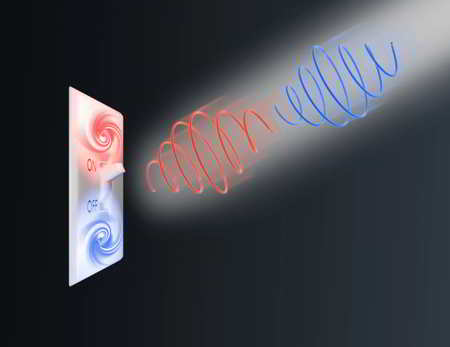From Max Planck Institute: New Type of Light-controlled Non-volatile Memory
Discovery establishes new mechanism that may lead to light-controlled, ultrafast and stable ferroic switching, and promising platform for next-gen non-volatile data storage technologies
This is a Press Release edited by StorageNewsletter.com on October 24, 2025 at 2:00 pmFrom Max Planck Institute for the Structure and Dynamics of Matter
Ferroic materials, like ferromagnets and ferroelectrics, are central building blocks of modern data storage technology.
 Yet, current platforms face fundamental limits. Ferromagnets suffer from low switching speed, while the ferroelectric polarization is generally unstable because of the depolarizing response of the surrounding material. A newly discovered class of materials, which do not suffer from these limitations, are so-called ferroaxials.
Yet, current platforms face fundamental limits. Ferromagnets suffer from low switching speed, while the ferroelectric polarization is generally unstable because of the depolarizing response of the surrounding material. A newly discovered class of materials, which do not suffer from these limitations, are so-called ferroaxials.
They are formed by microscopic vortices of electric dipoles that can either be arranged in a clockwise or anticlockwise texture, yet they are extremely difficult to manipulate. researchers at the Max Planck Institute for the Structure and Dynamics of Matter (MPSD) and the University of Oxford have now shown that the bi-stable ferroaxial states can be switched on demand using single ultrashort flashes of circularly polarized terahertz light.
This discovery establishes a new mechanism that may lead to light-controlled, ultrafast and stable ferroic switching, and a promising platform for next-gen non-volatile data storage technologies.
Terahertz light can reversibly switch an unusual form of structural order
in solids – called ferroaxiality – between clockwise and counterclockwise rotational patterns.
© Jörg Harms (MPSD)
Ferroic materials are solids that can be switched between two stable states. The most familiar examples are ferromagnets, which can be magnetized in opposite directions, and ferroelectrics, which can hold opposite electric polarizations. Because these states are readily switchable by magnetic or electric fields, ferroic materials are widely used in today’s data storage and electronic technologies.
Ferroaxial materials are a recent addition to the ferroic family. Instead of magnetic or electric states, these solids host vortices of electric dipoles that can be oriented in two opposite directions without creating a net magnetization nor electric polarization. These are very stable and are unaffected by external fields, but for the same reason very difficult to control, which has limited their exploration until now.
The research team, led by Andrea Cavalleri, used circularly polarized terahertz light pulses to switch between clockwise and anti-clockwise ferroaxial domains in a material termed rubidium iron dimolybdate (RbFe(MoO4)2.
 “We take advantage of a synthetic effective field that arises when a terahertz pulse drives ions in the crystal lattice in circles,“ says Zhiyang Zeng, lead author of this work. “This effective field is able to couple to the ferroaxial state, just like a magnetic field would switch a ferromagnet or an electric field would reverse a ferroelectric state,” he added.
“We take advantage of a synthetic effective field that arises when a terahertz pulse drives ions in the crystal lattice in circles,“ says Zhiyang Zeng, lead author of this work. “This effective field is able to couple to the ferroaxial state, just like a magnetic field would switch a ferromagnet or an electric field would reverse a ferroelectric state,” he added.
 “By adjusting the helicity, or twist, of the circularly polarized light pulses, we can selectively stabilize a clockwise or anti-clockwise rotational arrangement of the electric dipoles,” continues Michael Först, fellow author, “in this way enabling information storage in the two ferroic states. Because ferroaxials are free from depolarizing electric or stray magnetic fields, they are extremely promising candidates for stable, non-volatile data storage.”
“By adjusting the helicity, or twist, of the circularly polarized light pulses, we can selectively stabilize a clockwise or anti-clockwise rotational arrangement of the electric dipoles,” continues Michael Först, fellow author, “in this way enabling information storage in the two ferroic states. Because ferroaxials are free from depolarizing electric or stray magnetic fields, they are extremely promising candidates for stable, non-volatile data storage.”
 “This is an exciting discovery that opens up new possibilities for the development of a robust platform for ultrafast information storage,” says Andrea Cavalleri, “it also shows how circular phonon fields, first achieved in our group in 2017, are emerging as a new re-source for the control of exotic materials phases“
“This is an exciting discovery that opens up new possibilities for the development of a robust platform for ultrafast information storage,” says Andrea Cavalleri, “it also shows how circular phonon fields, first achieved in our group in 2017, are emerging as a new re-source for the control of exotic materials phases“
This work was primarily supported by the Max Planck Society and by the Max-Planck Graduate center for Quantum Materials, supporting collaborations with the University of Oxford. The MPSD is also associated with and receives funding from the Deutsche Forschungsgemeinschaft via the Cluster of Excellence ‘CUI: Advanced Imaging of Matter’. The MPSD is a partner of the Center for Free-Electron Laser Science (CFEL) with DESY and the University of Hamburg.
Article: Photo-induced nonvolatile rewritable ferroaxial switching
Science has published an article written by Z. Zeng, Max Planck Institute for the Structure and Dynamics of Matter, Hamburg, Germany, and Department of Physics, Clarendon Laboratory, University of Oxford, Oxford, UK, M. Först, M. Fechner, Max Planck Institute for the Structure and Dynamics of Matter, Hamburg, Germany, D. Prabhakaran, P. G. Radaelli, Department of Physics, Clarendon Laboratory, University of Oxford, Oxford, UK, and A. Cavalleri, Max Planck Institute for the Structure and Dynamics of Matter, Hamburg, Germany, and Department of Physics, Clarendon Laboratory, University of Oxford, Oxford, UK.
Abstract: “Ultrafast switching of ferroic phases is an active research area with technological potential. Yet, some key challenges remain, ranging from limited speeds in ferromagnets to intrinsic volatility of switched domains owing to depolarizing fields in ferroelectrics. Unlike these ferroic systems, ferroaxial materials host bistable states that preserve spatial-inversion and time-reversal symmetry and are therefore immune to depolarizing fields but also difficult to manipulate with conventional methods. We demonstrate photo-induced switching of ferroaxial order by engineering an effective axial field composed of circularly driven terahertz phonon modes. A switched ferroaxial domain remains stable for many hours and can be reversed back with a second terahertz pulse of opposite helicity. The effects demonstrated in this work may lead to the development of a robust platform for ultrafast information storage.“














 Subscribe to our free daily newsletter
Subscribe to our free daily newsletter

